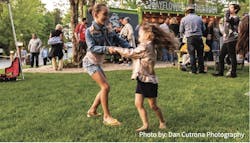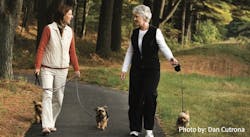Pandemic Alters Perceptions of Space and Density
Land planning has been evolving for years, with a growing emphasis on sustainability, community building, integration with transportation planning, and the quality of shared spaces. The COVID-19 pandemic is hastening that evolution in profound ways, and may bring changes in planning and design that will shape neighborhoods and communities for generations.
The pandemic has brought three notable changes in the way people perceive and interact with the built environment.
First, over the course of one extraordinary year, millions of office-bound professionals have recognized that they can be productive while working from home.
Second, the pandemic has dramatically altered peoples’ perceptions of space and density. Some planners suggest this may lead to a step backward for advocates of smart growth and a victory for designs that promote sprawl.
Third, the unprecedented public health response to COVID-19, including social distancing requirements and remote work, has brought a renewed sense of the importance of the home. At a time when homes have become workplaces, schools, gyms, day care centers and more, they have, more than ever before, become the foundation of personal security.
Each of these three changes will likely affect consumer desires and expectations for housing and communities. That means changes are coming to land planning and architecture. Builders will have to adapt to the new expectations. Ultimately, the changes will have a significant impact on the built environment.
Looking first at remote work, surveys suggest that millions of Americans enjoy working from home. Perhaps more important, the nation’s executives have seen that many of their employees can work from home without sacrificing productivity.
“There will be a huge net gain for telecommuting – working from home,” said Dean Wehrli, Ph.D., Principal, John Burns Real Estate Consulting in Sacramento, Calif. “It will be in the millions. It’s not going to be what it is now – folks are going to be pulled back into the office. But the residual will be a much, much bigger presence than was true prior to COVID. And that’s going to have tremendous impact on product and on community.”
Government officials from New York and San Francisco have already begun planning for a post-COVID world and the expectation that many “downtown” office jobs, and related retail and hospitality employment, won’t be coming back.
If a substantial percentage of the workforce chooses to work from home in the future, demand for high-density multifamily housing in central cities may be affected, at least in the next year, as public health officials take stock of the effectiveness of vaccines and the broader campaign to slow the spread of COVID-19. NAHB’s Home Building Geography Index (HBGI) indicates that multifamily housing in large metro areas, particularly core and suburban counties, lost significant market share in 2020.
This slowing may have even more effect on mixed-use development, if demand for urban office space and retail is slow to rebound.
The second issue – peoples’ perceptions of space and density – may affect consumers’ location preferences for years to come. NAHB economists note a shift in desire for suburban and exurban living.
Demands for social distancing and reports of high coronavirus case rates in dense urban areas quickly made urban living much less desirable. At the same time, consumers across the economic spectrum began to take advantage of lower housing costs in the suburbs and exurbs.
But amid the worst pandemic in 100 years and millions of job losses, the nation’s housing affordability crisis has not abated.
It’s time for new ways of looking at the problem, says Chris Moore, Chief Executive Officer of DTJ Design in Boulder, Colo.
“Entrenched zoning regulations drive us toward solutions that are not appropriate for today’s marketplace,” Moore said. “That conventional thinking happens at all levels – at the yard, at the house, at the street, and at the neighborhood.
“We need to overcome that way we think about small-lot product,” Moore said.
“We need to challenge assumptions about multiple levels – the idea that people can’t live in multi-level homes into their 50s and 60s and beyond,” Moore said. “We need to challenge assumptions about the amount of covered parking required for a given number of units. We need to challenge assumptions about bedroom count. We’ve been building homes for decades under the premise that there must be at least three bedrooms.”
How will the COVID-19 pandemic affect smart growth initiatives and the effort to change land use patterns that lead to sprawl? In the short term, the pandemic may lead to a “net victory for sprawl,” Wehrli said. But the trend toward smart growth will continue in the long term.
“Think about the transit hub,” Wehrli said. “All the reasons planners were putting higher density at transit centers before will still be true after COVID.”
If one constant has shown in this challenging time, it is the significance of “home.” The home has always been central to American life. But during the COVID-19 pandemic, it has become more than just school, workplace and gym. In an incredibly difficult year, it has become refuge.
Wehrli notes the importance of outdoor spaces during the pandemic, and predicts that spaces that can combine the indoor and the outdoor are going to be critical, even after COVID.
“If I had to pick one massive trend, it’s indoor-outdoor connectivity,” Wehrli said. “It innately provides this rush to the outdoors that we have all felt because of COVID.”
Developments that include shared green spaces, walking and biking trails, community gardens, public event spaces and other outdoor amenities will be even more attractive to consumers as the nation rebounds from COVID.
“We must have pocket open spaces,” said DTJ’s Moore. “There needs to be something in proximity of someone’s home that they can easily walk to. We’ve created communities with shaded areas and community Wi-Fi, where residents can go out during a certain time of day and use that space as their office. They can get out of their house, and you’ve created something within the neighborhood fabric that is interesting.”
Another piece of advice: “Put a dog park in your master community, I’m begging you,” Wehrli said. “The adoption of dogs is exploding, and that’s a great thing.”



